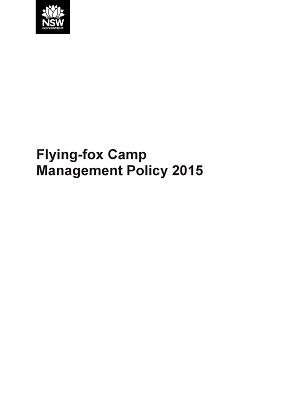During the day, flying-foxes roost in trees. The places they roost are known as camps and may contain tens to thousands of individuals at a time. At night, flying-foxes disperse from camps to feed across the landscape.
Flying-foxes are protected in New South Wales by the Biodiversity Conservation Act 2016.
It is an offence under the Act to harm or attempt to harm a native animal unless authorised by a biodiversity conservation licence or approved code of practice, or an exemption under the Biodiversity Conservation Regulation 2017.
Flying-fox conservation
Saving our Species is the NSW Government's statewide program that aims to secure threatened plants and animals in the wild in New South Wales. Under this program, the grey-headed flying-fox is assigned to the Landscape species management stream. Landscape-managed species are best helped by addressing threats such as habitat loss or degradation within a landscape.
The conservation project for the grey-headed flying-fox includes an action toolbox of priority actions to address key threats that a range of stakeholders could undertake.
Key threats to flying-foxes
Flying-foxes face a number of threats. The most significant threat is the loss of foraging and roost habitat. This plays a role in times of food shortage, during which large numbers of flying-foxes may die from starvation.
Flying-fox deaths also occur from a range of human-induced threats. An examination of wildlife carer records found that entanglements in barbed-wire and large-aperture fruit netting, electrocutions on powerlines and extreme heat events are among the highest causes of flying-foxes requiring rescues.
For more information, visit:
Impacts of flying-fox camps on communities
Flying-fox camps close to urban and regional settlements can create issues for the community and require proactive management. People may be impacted by noise, odour and flying-fox droppings. These issues can be addressed by effective camp management actions and working with impacted communities.
The Department of Climate Change, Energy, the Environment and Water Flying-fox Camp Management Policy 2015 empowers land managers, primarily local councils, to work with their communities to manage flying-fox camps effectively. The primary purpose of this policy is to minimise the health and lifestyle impacts of flying-fox camps on people while avoiding unnecessary harm to flying-foxes.
The focus of the policy is to minimise the immediate impacts of flying-foxes on people, as well as a longer-term approach to the sustainable management of flying-fox camps and streamlined authorisation of actions at or near camps.
For more information, visit:
Flying-foxes and commercial crops
Flying-foxes can potentially impact commercial fruit growers, especially during prolonged periods of flying-fox food shortages such as drought.
The most reliable method for mitigating impacts is using full-exclusion netting or throwover netting.
An independent review of licensing was commissioned in 2008, to assess the validity of the NSW licensing policy for the legal harm (including killing) of flying-foxes.
This review concluded that shooting is ineffective when larger numbers of flying-foxes visit orchards and contributes to the species' decline. In response to the review panel's recommendations, licences to harm flying-foxes were only granted under special circumstances from July 2015 to June 2021.
Since 1 July 2021, the shooting of flying-foxes is not permitted in New South Wales.
For more information, visit:
Key management approaches












